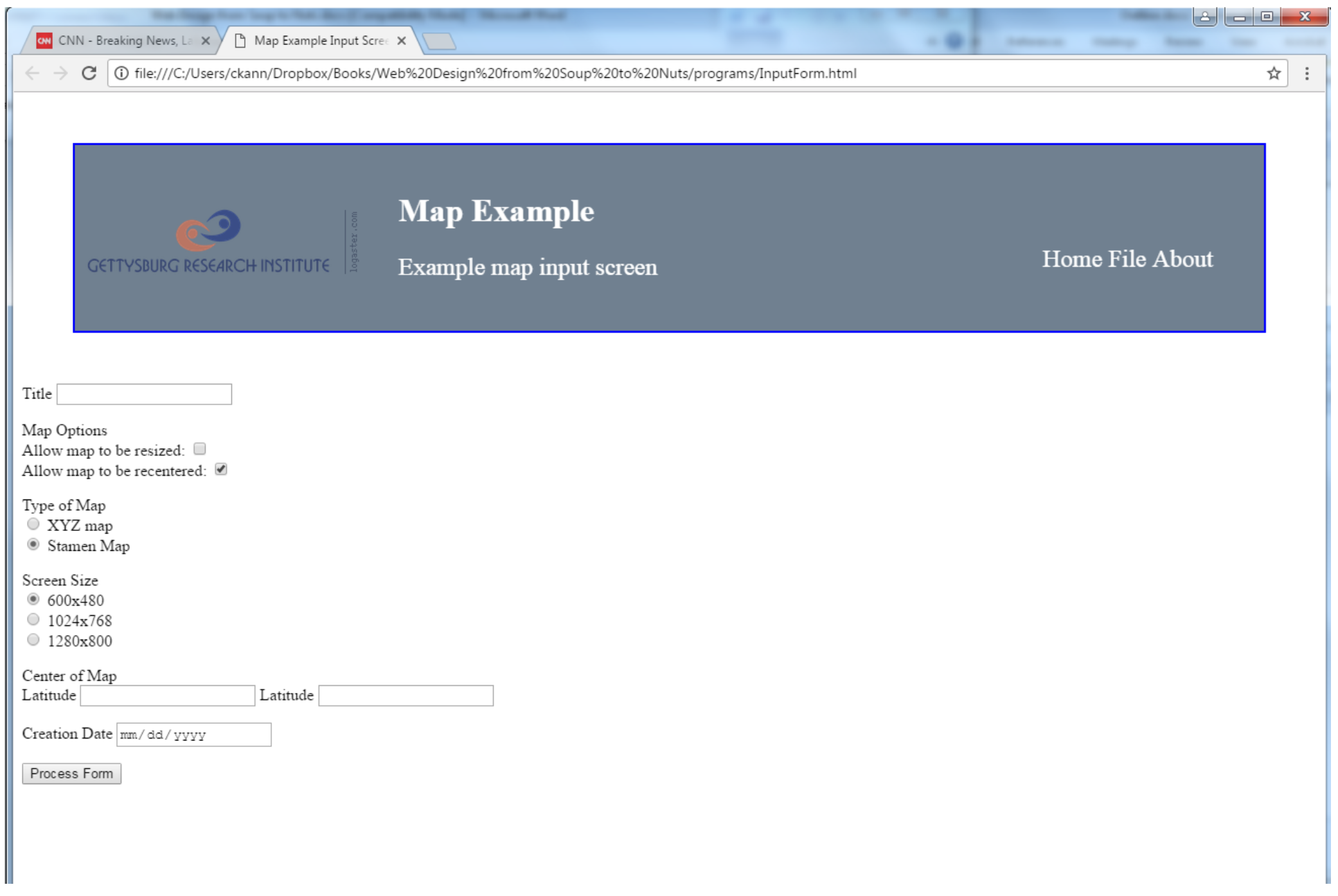Books / Introduction to HTML, CSS and JavaScript / Chapter 14
Adding the form to the Page
After the header has been developed, the form is added to the page. For now, only the display of the form will be presented to make the concepts clearer. Later, this chapter will show how CSS can be used with JavaScript to control display of the form.
If the form is simply added to the page, as shown below, it looks very unprofessional. While it is functional, it is ugly and would not inspire confidence from the users that the web page actually works.

A much nicer layout of the form follows. The following is the form display that will be styled using CSS. Following the form, the CSS and HTML are presented here and an explanation of all the elements is given.

CSS Example
Here’s Form CSS example:
header {
margin : 5px 50px 5px 50px;
border : 2px solid blue;
background-color : slategray;
color : white;
}
header p {
font-size : 150%;
}
.header-icon {
display : inline-block;
margin: 50px 10px 50px
}
.header-desc {
display : inline-block;
margin : 25px;
}
.header-menu {
display : inline-block;
float: right;
margin : 75px 50px 50px 50px;
}
#inputForm {
margin : 10px 5px 5px 50px;
background-color : beige;
border : 2px solid black;
display: inline-block;
float : left;
padding : 20px;
width : 20%;
height : 70%;
}
#map {
margin : 0px 50px 5px 5px;
background-color : beige;
border : 2px solid black;
display: inline-block;
float : right;
padding : 20px;
width : 67%;
height : 70%;
}
input:-moz-read-only { /* For Firefox */
background-color: lightgray;
}
input:read-only {
background-color: lightgray;
}
The CSS for the head has been defined, and that leaves just 4 CSS tags
to cover here. The first are the #form and #map id tags. These two
tags create boxes displayed on the web page to contain other form
elements. The #form is 20% of the size of the page, and the #map is
67% the size of the page and is anchored to the right of the page using
the float:right attribute. The inline:block attribute tells CSS to put
both on the same line. Since they only take up 87% of the line, 13% of
the line will not be included in either division and left blank between
the two pages. Both or the div sections have black boarder 2 pixels in
size, and both will take up 70% of the height of the page, with the rest
used by the header. Finally, the padding says leave some room on the
right and left of the divisions before rendering the text.
The final two tags, the input:-moz-read-only and input:read-only tags,
are to gray out any input tags which are read only, e.g. the value for
these input fields cannot be typed in by the user and must be set
programmatically. These are the read only fields on the map for latitude
and longitude.
Complete Form Example with HTML
<html>
<head>
<title>Map Example Input Screen </title>
<link rel="stylesheet" type="text/css" href="WebMapExample.css">
</head>
<body>
<header>
<div class="header-icon">
<img src="GRI_logo.png" />
</div>
<div class="header-desc">
<h1>Map Example</h1>
<p class="header-p">
Example map input screen
</p>
</div>
<div class="header-menu">
<p class="header-p">
Home File About
</p>
</div>
</header>
<section id="inputForm" />
<p>
<label id="l1" for="title">Title</label>
<input type="text" id="title" size="20">
</p>
<p>
Map Options<br>
<label id="l2" for="resize">Allow map to be resized:
</label>
<input type="checkbox" id="resize"/>
<br/>
<label id="l3" for="recenter">
Allow map to be recentered:
</label>
<input type="checkbox" id="recenter" checked />
</p>
<p>
Type of Map<br>
<input type="radio" name="maptype" id="XYZMap"
value="XYZ Map"/>
<label id="label1" for="XYZMap">XYZ map </label>
<br/>
<input type="radio" name="maptype" id="StamemMap"
checked />
<label id="label2" for="StamenMap">Stamen Map
</label>
</p>
<p>
Screen Size<br>
<input type="radio" name="screenSize" checked
id="600x480" value="600x480" />
<label id="label3" for="XYZMap">600x480 </label>
<br/>
<input type="radio" name="screenSize" id="1024x768"
value="1024x768"/>
<label id="label4" for="XYZMap">1024x768 </label>
<br/>
<input type="radio" name="screenSize" id="1280x800"
value="1280x800"/>
<label id="label5" for="XYZMap">1280x800 </label>
</p>
<p>
Center of Map<br>
<label id="label1" for="lat">Latitude
</label>
<input type="number" id="lat" value="-77" readonly /><br />
<label id="label2" for="long" >Longitude </label>
<input type="number" id="long" value="39" readonly />
</p>
<p>
<label id="label1" for="creationDate">Creation Date
</label>
<input type="date" id="creationDate"/>
</p>
<input type="button" value="Process Form" />
</section>
<section id="map">
<h1> This is where the map will go </h1>
</section>
</body>
</html>

For the HTML for the page, the only change was to add two section tags to create sections for the form and the map. The section tag is a div tag that has a semantic meaning. A section to a for is a completely separate part of the form. A division has no semantic meaning.




